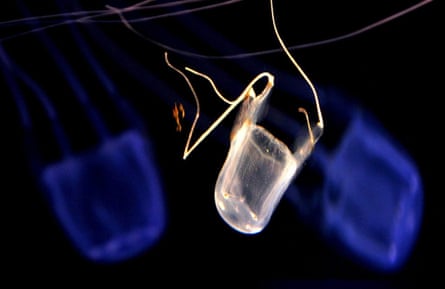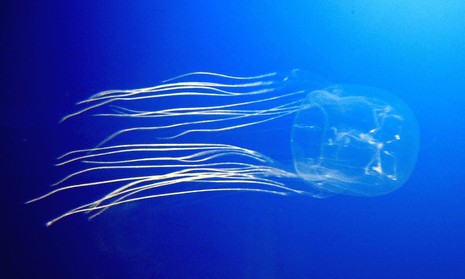The box jellyfish Chironex fleckeri is infamous. Its venom will kill a human within minutes. This much I’ve known for decades. What I didn’t know until yesterday is that C. fleckeri has 24 eyes and appears to sleep.
More than a decade ago, researchers in Australia superglued acoustic transmitters to several box jellyfish (without getting stung) and set them free. Using an underwater microphone, they were then able to track their movements. The results were completely unexpected.
During the daytime, the jellyfish moved in straight lines, typically covering around 200 m an hour. At night, they basically stopped. “During these periods of “inactivity”, the jellyfish lie motionless on the sea floor, with no bell pulsation occurring and with tentacles completely relaxed and in contact with the sea floor,” wrote Jamie Seymour, a biologist at James Cook University in Cairns in The Medical Journal of Australia. A small disturbance – like a light or a vibration – “causes the animals to rise from the sea floor, swim around for a short period, and then fall back into an inactive state on the sand,” they reported.
The clear distinction between activity and rest raises the possibility that the box jellyfish is capable of sleep, a state most commonly associated with vertebrates. Why would a box jellyfish need to sleep? One possibility, suggested by Seymour and his colleagues, is that it uses its eyes to hunt. In the dark, when vision is limited, “it makes a lot of sense to become inactive, decrease your energy used in locomotion and divert it to growth.”

Another idea, put forward by evolutionary biologist Lee Kavanau, is that eyes – for all their obvious evolutionary advantages – require huge neurological processing. So the evolution of eyes paved the way for the emergence of two distinct states of vigilance. One – wakefulness – allowed the animal to focus on the analysis of complex visual information and the split-second making of decisions. The other – sleep – became the brain’s opportunity to process information without being overloaded by the senses.

Comments (…)
Sign in or create your Guardian account to join the discussion